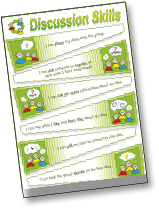Jo Chessum, SENCo, takes a closer look at the importance of promoting and developing discussion skills as part of the Spoken Language Curriculum.
Think about the number of opportunities for discussion that you have given your class this week. I would guess that there have been a number of times when you have asked children to ‘talk with a partner’ with the aim of developing their thinking and extending their answers to questions. Now think about the feedback you have given. I could almost guarantee that your focus will have been on the answers that children have given, not on how well they have used their discussion skills.
We know that feedback has been highlighted as one of the cheapest yet most effective ways of promoting progress and that children knowing the ‘next steps’ for learning is high on the agenda. We also know that developing children’s discussion skills, through collaborative activities, can lead to improved outcomes across the curriculum and promote deeper learning. But do we teach children the skills they need for effective discussion?
Providing opportunities for discussion is not enough to improve children’s spoken language. Evidence suggests that collaborative learning is most effective when both individual and group goals are present (Slavin, 2010). As such, discussion tasks need to be structured and learning outcomes differentiated, exactly like any other learning activity. Children need to know that the purpose of any discussion is to reach a decision or agreement by …
- Making suggestions and sharing ideas.
- Asking questions to understand others’ ideas.
- Asking questions to find out more about others’ ideas.
- Sharing opinions about others’ ideas.
- Building on the ideas of others.
- Helping the group to reach a decision or agreement.
Reference:
Slavin, R (2010), The Nature of Learning.
Why not have a go at using these guidelines to develop planning and provide effective feedback for extended discussion tasks?
Next Steps…
STEP 1
Teach the Skills of Discussion
Introduce children to the key skills and language involved in effective discussion … they need to know what they are aiming for. Provide sentence starters or word banks to support and encourage each skill.
STEP 2
Provide Visual Support
Display effective discussion skills in your classroom to provide reinforcement. Even when you are not focusing on developing discussion skills, children will begin to refer to them when they are working in Talk Partners or when they realise anything they are doing is discussion based.
STEP 3
Model the Skills of Discussion
Set up situations for children to observe effective discussion – remember you provide the best model of language for your class! Pause during your discussion and ask children to identify the skill that you are using.
STEP 4
Identify Areas for Development
Children need to understand how they are performing in discussion tasks before they know what to do to improve. Providing a ball of string to be passed between children and looped around their finger can help them to see if they are dominating a discussion or not contributing enough.
STEP 5
Set Individual Targets
Children who make limited contributions in discussions may need to focus on making suggestions and sharing ideas; others may make lots of relevant contributions but need to ask questions for clarity or more information. Personalise targets so that the successful completion of tasks relies on individual performance as well as the group reaching a decision.
STEP 6
Provide Practical Prompts
Use our free ‘Discussion Tokens’ to provide children with a tangible record of which skills they need to develop in order to improve their performance. As they use a skill, they place the relevant token in the centre of the table – the task is only complete when all tokens have been ‘spent’ and the group have reached a decision.


Please login to view this content
Login